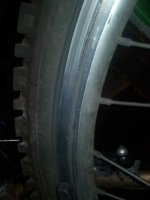Hi EPFMs,
I have a dilemma on my hands. Today, I was having this weird prominent jarring with my back brakes. When I looked at it, I found that one of the brake clamps had a broken spring. Had to ride home without back brakes.
When I came home and swapped my clamps with one's I have from my other bike, I discovered something far more alarming. I found a 5 cm long split in my hub motor's rim.
I want to know, how bad is it to ride on this type of split until I can get it repaired or replaced? I need my bike for my work and I may not be able to afford to get this fixed immediately. I don't exactly have a spare rim or hub motor for this.
Here's a photo of the damage.
Any suggestion of what I can do in the mean time would be appreciated.
I have a dilemma on my hands. Today, I was having this weird prominent jarring with my back brakes. When I looked at it, I found that one of the brake clamps had a broken spring. Had to ride home without back brakes.
When I came home and swapped my clamps with one's I have from my other bike, I discovered something far more alarming. I found a 5 cm long split in my hub motor's rim.
I want to know, how bad is it to ride on this type of split until I can get it repaired or replaced? I need my bike for my work and I may not be able to afford to get this fixed immediately. I don't exactly have a spare rim or hub motor for this.
Here's a photo of the damage.
Any suggestion of what I can do in the mean time would be appreciated.


